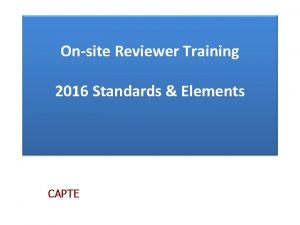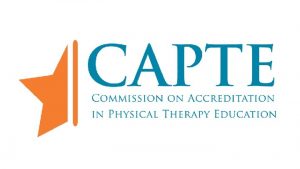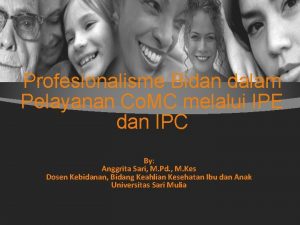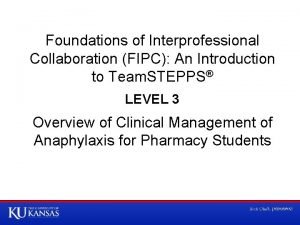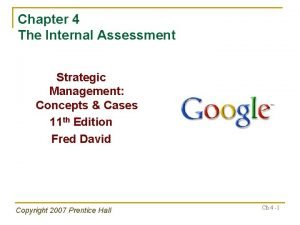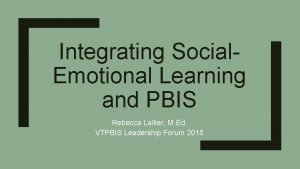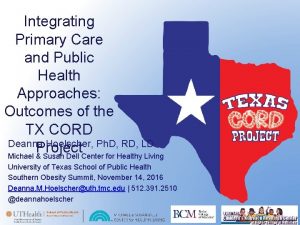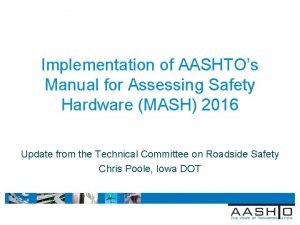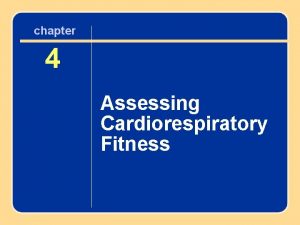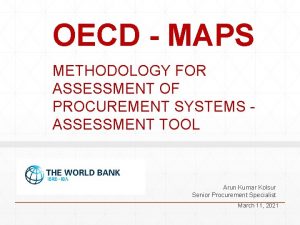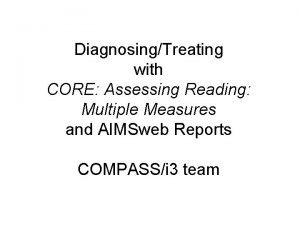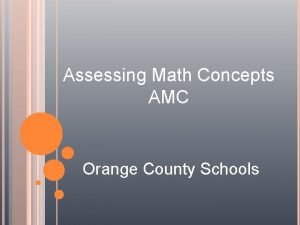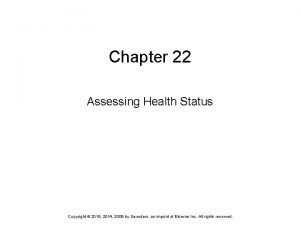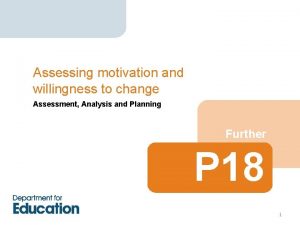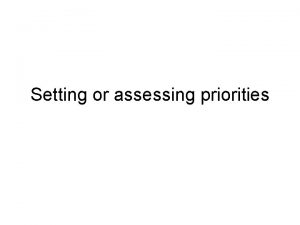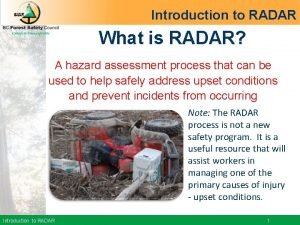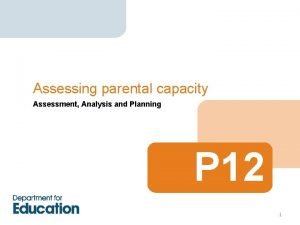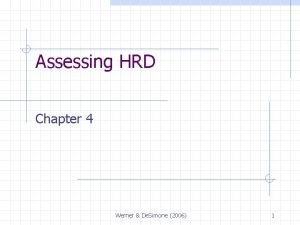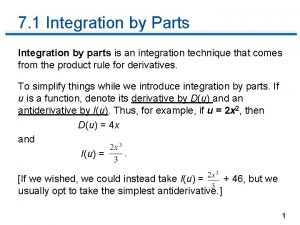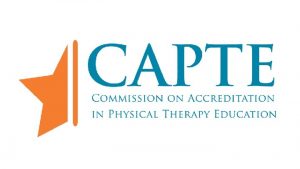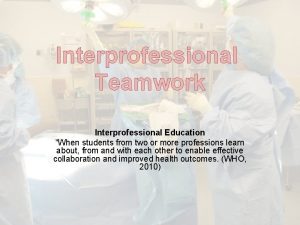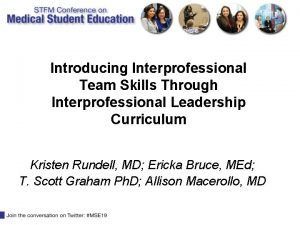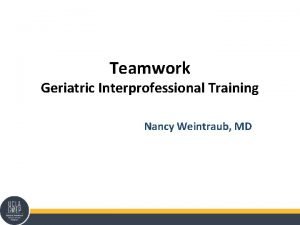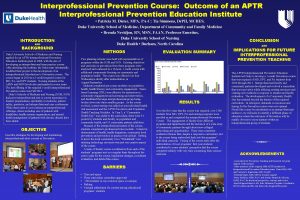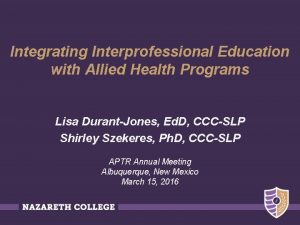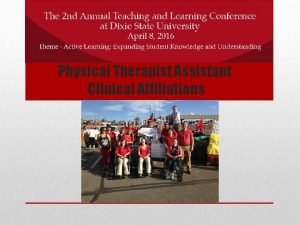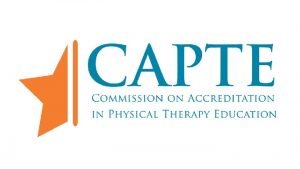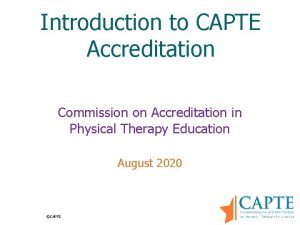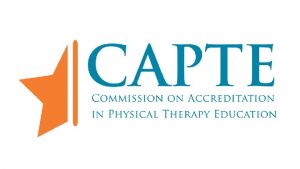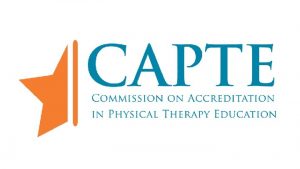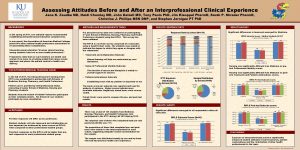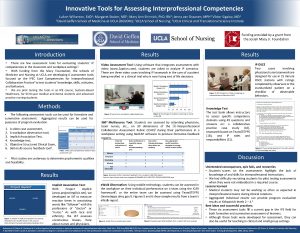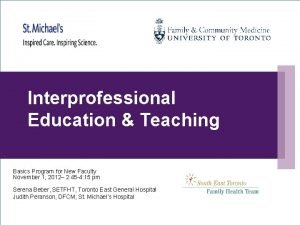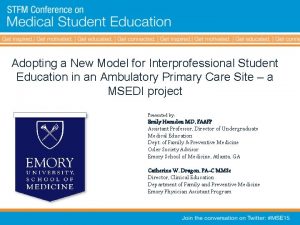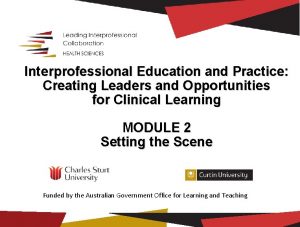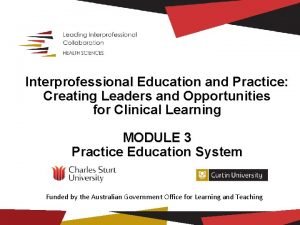Integrating and Assessing the New CAPTE Interprofessional Education



















































































































- Slides: 115

Integrating and Assessing the New CAPTE Interprofessional Education Standards in the Clinic Cheryl Resnik, PT, DPT, FNAP Debora Brown, PT, DPT, FNAP Samantha Brown, PT, DPT Robert W. Nithman, PT, DPT, GCS Pamela D. Ritzline, PT, Ed. D National Interprofessional Education Consortium

Objectives 1. Summarize the CAPTE IPE standards and their relationship to the IPEC core competencies 2. Explain the value of incorporating the core competencies to promote clinical excellence to clinical partners 3. Identify instructional strategies to prepare students and academic and clinical faculty for integration of IPE into the clinical setting 4. Design IP activities for their students’ use in the clinic based upon the core competencies National Interprofessional Education Consortium

Outline 1. IPE & collaborative practice definition and goals, Triple Aim and quality outcome measures 2. Review of IPEC core competencies 3. CAPTE standards review 4. Examples of objectives and specific CAPTE outcome assessments 5. Examples of instructional strategies 6. Implementation requirements 7. Integrating the clinical instructor community National Interprofessional Education Consortium

What is Interprofessional Education (IPE)? “Interprofessional education occurs when students from two or more professions learn about, from, and with each other to enable effective collaboration and improve health outcomes. Once students understand how to work interprofessionally, they are ready to enter the workplace as a member of the collaborative practice team. This is a key step in moving health systems from fragmentation to a position of strength. ” Source: World Health Organization (WHO). (2010). Framework for action on interprofessional education & collaborative practice. Geneva: World Health Organization. See http: //whqlibdoc. who. int/hq/2010/WHO_HRH_HPN_10. 3_eng. pdf. National Interprofessional Education Consortium

Institute for Healthcare Improvement: The IHI Triple Aim A framework for optimizing health system performance by simultaneously focusing on the health of a population, the experience of care for individuals within that population, and the per capita cost of providing that care. . National Interprofessional Education Consortium

The Interprofessional Education Collaborative (IPEC) In 2009 six national education associations of schools of the health professions formed a collaborative to promote and encourage efforts that would advance substantive interprofessional learning experiences to help prepare future health professionals for enhanced team based care of patients and improved population health outcomes. https: //ipecollaborative. org/About_IPEC. html National Interprofessional Education Consortium

Founding members • American Association of Colleges of Nursing (AACN) • American Association of Colleges of Osteopathic Medicine (AACOM) • American Association of Colleges of Pharmacy (AACP) • American Dental Education Association (ADEA) • Association of American Medical Colleges (AAMC) • Association of Schools and Programs of Public Health (ASPPH) National Interprofessional Education Consortium

New institutional members • American Association of Colleges of Podiatric Medicine (AACPM) • American Council of Academic Physical Therapy (ACAPT) • American Occupational Therapy Association (AOTA) • American Psychological Association (APA) • Association of American Veterinary Medical Colleges (AAVMC) • Association of Schools and Colleges of Optometry (ASCO) • Association of Schools of Allied Health Professions (ASAHP) • Council on Social Work Education (CSWE) • Physician Assistant Education Association (PAEA) National Interprofessional Education Consortium

Supporting organizations • Academic Consortium for Complementary & Alternative Health Care (ACCAHC) • American Physical Therapy Association (APTA) • American Speech Language Hearing Association (ASHA) • Association of Schools of Allied Health Professions (ASAHP) • Society of Simulation in Healthcare (SSH) National Interprofessional Education Consortium

Interprofessional Collaboration Competency Domain National Interprofessional Education Consortium

Four Core Competencies The core competencies and sub competencies feature the following desired principles: – patient and family centered – community and population oriented; – relationship focused; – process oriented; – linked to learning activities, educational strategies, and behavioral assessments that are developmentally appropriate for the learner; – able to be integrated across the learning continuum; – sensitive to the systems context and applicable across practice settings; – applicable across professions; – stated in language common and meaningful across the professions; and – outcome driven https: //ipecollaborative. org/uploads/IPEC 2016 Updated Core Competencies Report__final_release_. PDF National Interprofessional Education Consortium

Competency 1 Work with individuals of other professions to maintain a climate of mutual respect and shared values. (Values/Ethics for Interprofessional Practice) VE 5 Work in cooperation with those who receive care, those who provide care, and others who contribute to or support the delivery of prevention and health services and programs. National Interprofessional Education Consortium

Competency 2 Use the knowledge of one’s own role and those of other professions to appropriately assess and address the health care needs of patients and to promote and advance the health of populations. (Roles/Responsibilities) RR 3. Engage diverse professionals who complement one’s own professional expertise, as well as associated resources, to develop strategies to meet specific health and healthcare needs of patients and populations. National Interprofessional Education Consortium

Competency 3 Communicate with patients, families, communities, and professionals in health and other fields in a responsive and responsible manner that supports a team approach to the promotion and maintenance of health and the prevention and treatment of disease. (Interprofessional Communication) CC 3. Express one’s knowledge and opinions to team members involved in patient care and population health improvement with confidence, clarity, and respect, working to ensure common understanding of information, treatment, care decisions, and population health programs and policies. National Interprofessional Education Consortium

Competency 4 Apply relationship building values and the principles of team dynamics to perform effectively in different team roles to plan, deliver, and evaluate patient/population centered care and population health programs and policies that are safe, timely, efficient, effective, and equitable. (Teams and Teamwork) TT 9. Use process improvement to increase effectiveness of interprofessional teamwork and team based services, programs, and policies. National Interprofessional Education Consortium

Interprofessional Education and CAPTE IPE education CAPTE IPE collaboratio n National Interprofessional Education Consortium

New CAPTE Standards Effective date Definitions Standards and Elements Interprofessional Competency Domains National Interprofessional Education Consortium

New CAPTE Standards Effective date National Interprofessional Education Consortium

CAPTE Definitions • Interprofessional Education Occurs when two or more professions learn with, from and about each other to improve collaboration and the quality of care. (WHO, 2002) National Interprofessional Education Consortium

CAPTE Definitions • Interprofessional Practice When multiple health workers from different professional backgrounds work together with patients, families, carers [sic], and communities to deliver the highest quality of care. (WHO, 2010) National Interprofessional Education Consortium

New CAPTE Standards • Standards and Elements – 6 F – 6 L 3 – 7 D 7 – 7 D 28 – 7 D 37 – 7 D 39 s National Interprofessional Education Consortium

Interprofessional Collaborative Practice Competency Domains • Competency Domain 1 (VE 1 – VE 10) – Values/Ethics for Interprofessional Practice • Competency Domain 2 (RR 1 – R 9) – Roles/Responsibilities • Competency Domain 3 (CC 1 - CC 8) – Interprofessional Communication • Competency Domain 4 (TT 1 – TT 11) – Teams and Teamwork Interprofessional Education Collaborative Expert Panel. (2011). Core competencies for interprofessional collaborative practice: Report of an expert panel. Washington, D. C. : Interprofessional Education Collaborative. National Interprofessional Education Consortium National

CAPTE Standard 6 F The didactic and clinical curriculum includes interprofessional education; learning activities are directed toward the development of interprofessional competencies including, but not limited to, values/ethics, communication, professional roles and responsibilities, and teamwork. NOTE: Effective January 1, 2018 Correlates with all 4 IPEC Competency Domains National Interprofessional Education Consortium

CAPTE Standard 6 L 3 6 L The curriculum plan includes clinical education experiences for each student that encompass, but are not limited to: 6 L 3 involvement in interprofessional practice (VE 5, RR 4, RR 6, RR 7, RR 8, RR 9, CC 2, CC 3, CC 4, CC 8, TT 3, TT 4, TT 7, TT 11) National Interprofessional Education Consortium

CAPTE Standard 7 D 7 Professional Ethics, Values and Responsibilities Communicate effectively with all stakeholders, including patients/clients, family members, caregivers, practitioners, interprofessional team members, consumers, payers, and policymakers. (VE 5, RR 1, RR 3, RR 4, RR 6, RR 7, CC 1 -CC 8, TT 6) National Interprofessional Education Consortium

CAPTE Standard 7 D 28 Management of Care Delivery Manage the delivery of the plan of care that is consistent with professional obligations, interprofessional collaborations, and administrative policies and procedures of the practice environment. (VE 5, VE 6, VE 7, VE 9, VE 10, RR 1, RR 2, RR 5, RR 8, CC 3, TT 4, TT 7, TT 10) National Interprofessional Education Consortium

CAPTE Standard 7 D 37 Participation in Health Care Environment Assess and document safety risks of patients and the healthcare provider and design and implement strategies to improve safety in the healthcare setting as an individual and as a member of the interprofessional healthcare team. (VE 1, VE 5, VE 7, VE 10, RR 2, RR 5, RR 6, TT 3, TT 7, TT 9, T 10, TT 11) National Interprofessional Education Consortium

CAPTE Standard 7 D 39 Participation in Health Care Environment Participate in patient-centered interprofessional collaborative practice. (VE 1, VE 2, VE 3, VE 4, VE 7, VE 9, RR 9, CC 2, CC 3, CC 8, TT 2, TT 3, TT 4) National Interprofessional Education Consortium

National Interprofessional Education Consortium

Integrating and Assessing the New CAPTE Interprofessional Education Standards in the Clinic The Value of Incorporating the Core Competencies to Promote Clinical Excellence with Clinical Partners ELC 2016 Robert W. Nithman, PT, DPT, Ph. D(c), GCS, COS-C Associate Professor, Midwestern University DPT Program Glendale, Arizona bnithman@midwestern. edu I do not have any relevant financial or non-financial relationships to disclose. National Interprofessional Education Consortium

Healthcare Statistics q 1 in 8 Medicare patients readmitted within 30 days of being release after surgery (RWJF) q 1 in 6 Medicare patients returned to a hospital within 1 month of leaving the hospital after receiving medical care (RWJF) q ~30% of patients older than 70 years and hospitalized for a medical illness are discharged with an ADL disability they did not have before becoming acutely ill (Covinsky et al) National Interprofessional Education Consortium

Healthcare Statistics q~50% of adults 85+ y/o will leave the hospital with a major new ADL disability (Covinsky et al) q US Healthcare system is the most costly in the world q Proportion of GDP projected to increase from 17% to 20% by 2020 (CMS, IHI) National Interprofessional Education Consortium

Clinical “Excellence” & IPCP Excellence: q Consistently using current knowledge and theory while understanding personal limits, integrating judgment and the patient/client perspective, embracing advancement, challenging mediocrity, and working towards the development of new knowledge. (APTA) National Interprofessional Education Consortium

Clinical “Excellence” & IPCP Quality q The degree to which health care services for individuals and populations increase the likelihood of desired health outcomes and are consistent with current professional knowledge. (IOM) Excellence Quality VALUE = Quality ÷ Cost National Interprofessional Education Consortium

National Interprofessional Education Consortium

National Interprofessional Education Consortium CMS. Gov

How do we sell “Value”? Big Picture Strategies q Population Health q Organizational Outcomes q Paradigm changes q APTA Core Values q Triple Aim Framework q Partner with others leading change (IPEC, NAP, etc. ) q “Collaborative practice” starts in the educational program but must also extend into the clinic… q Make the case that not working collaboratively affects the patient! National Interprofessional Education Consortium

IPEC Core Competencies Clinical Outcomes CMS Initiatives that talk our language! q. OBQI q. Bundled care q. Prospective Payment Systems q. Publically Reported Outcome Data q. Pay for Performance National Interprofessional Education Consortium

IPEC Core Competencies Clinical Outcomes CMS Programs that talk our language! q Shared Savings Programs q Accountable Care Organizations (ACOs), for ex. q Comprehensive Care for Joint Replacement Model (CJR) National Interprofessional Education Consortium

Are WE Prepared? q How well prepared are we from the education side to communicate with the clinical side? q Do we understand their challenges? q Are we prepared to be a content and change resource for our clinical partners? q Help them to “sell” IPE opportunities to their administrators, colleagues in other departments National Interprofessional Education Consortium

Strategies to Prepare Students and Clinical Faculty for Integration of IPE and IPP National Interprofessional Education Consortium

• • Background Rationale Assessment of Institutional Readiness Faculty and CI Development Common Language IP learning experiences Assessment Resources NIPEC’s IPE Activity/Project Summary Sheet National Interprofessional Education Consortium

Background • To engage in meaningful interprofessional opportunities in clinical education and practice, students need a solid IPE foundation established during the didactic portion of their education. • Transferable SKILLS in collaborative practice • Purposeful learning with assessment • Variety of experiences (Joseph 2013, Christopherson 2015, Freeth 2005, Bluteau 2009) National Interprofessional Education Consortium

Rationale Figure 1. Armstrong State University, Interprofessional Health Professions Collaboration. www. armstring. edu/health professions/interprofessional health professions collaboration. Accessed 9. 1. 2016 National Interprofessional Education Consortium

Assessment of Institutional Readiness • Create an Institutional Culture of Inter professionalism • Buy In from Key Stakeholders • Interprofessional Education Assessment and Planning Instrument for Academic Institutions National Interprofessional Education Consortium

National Interprofessional Education Consortium

National Interprofessional Education Consortium

Figure 2 The interprofessional learning continuum (IPLC) model. Institute of Medicine. Measuring the Impact of Interprofessional Education on Collaborative Practice and Patient Outcomes. Washington, DC: The National Academies Press, 2015. doi: 10. 17226/21726. National Interprofessional Education Consortium

Are Clinical Faculty Prepared to Model IPC? 1. ‘ACA is moving toward a team based system… academic institutions challenged to find sufficient clinical experiences for students in community based practices that serve as models of team based care needed for contemporary practice. ’ 1. ‘An alliance of education and practice will only be successful if the health care workforce is appropriately prepared for collaborative work… this is a shared responsibility between educational institutions and health care delivery systems. ’ 1) Advisory Committee on Interdisciplinary, Community Based Linkages (ACICBL). Transforming Interprofessional Health Education and Practice: Moving Learners from the Campus to the Community to Improve Population Health. 13 th Annual report to the Secretary of the US Department of Health and Human Services and the Congress of the US. October 2014. 2) Josiah Macy Foundation. Transforming Patient Care: Aligning Interprofessional Education with Clinical Practice Redesign. Conference Recommendations. January 2013. Atlanta, GA. National Interprofessional Education Consortium

Faculty and CI Development • Updates to Credentialed Clinical Instructor Program (CCIP)? • CE Courses – – – Team. STEPPS Master Trainers Academic Programs with IPE NEXUS Learning System AIHC Interprofessional Webinar Series AAMCs Med. Ed. PORTAL CE Directory General CE Programs • Faculty Development Tools – U Washington Faculty Training Toolkit – U Minnesota Academic Health Center Office of Education – U Kansas Center for Interprofessional Education National Interprofessional Education Consortium

American Interprofessional Health Collaborative U. S. Interprofessional Education Programs • • • • • • • Western University of the Health Sciences Virginia Commonwealth University Texas Tech University Health Sciences Center Jefferson Interprofessional Education Center, Thomas Jefferson University Center for Healthcare Improvement and Patient Safety, Perelman School of Medicine, University of Pennsylvania Oregon Health & Science University C 3, Creating Collaborative Care, Medical University of South Carolina University of Virginia REACH: University of Colorado Denver, Anschutz Medical Campus IPE Pitt: University of Pittsburgh Department of Bioethics and Interdisciplinary Studies, East Carolina University Office of Interprofessional Education, Creighton University Medical Center Inter. Professional Education Collaborative, University of New England Center for Health Science Interprofessional Education, Research & Practice, University of Washington University of Texas Medical Branch University of New Mexico University of Nebraska Vanderbilt University Grand Valley State University St Louis University of Kentucky University of Minnesota Rosalind Franklin University of Arizona University of Florida National Interprofessional Education Consortium University of Connecticut

Faculty and CI Development • Workshops – IPEC Conferences – T 3 Train the Trainer – University of Toronto Center for Interprofessional Education • Conferences – All Together Better Health (ATBH) – Collaborating Across Borders (CAB) – Interprofessional Health, Education and Practice International Conference (IHEP) – Learning Together at the NEXUS Summit National Interprofessional Education Consortium

Faculty and CI Development • IPECP Organizations National Center for Interprofessional Practice and Education (NEXUS) National Academies of Practice (NAP) Interprofessional Education Collaborative (IPEC) American Interprofessional Health Collaborative (AIHC) Institute for Healthcare Improvement (IHI) Center for the Advancement of Interprofessional Education (CAIPE) European Interprofessional Practice and Education network (EIPEN) Canadian Interprofessional Health Collaborative (CIHC) Australasian Interprofessional Practice and Education Network (AIPPEN) Transforming Interprofessional Groups through Educational Resources (TIGER) – Nordic Interprofessional Network (NIPNET) – – – – – See NIPEC page for hyperlinks! National Interprofessional Education Consortium

Common Language • IPEC core competencies • The Joint Commission’s do not use list of abbreviations • International Classification of Functioning Disability and Health (ICF) (Ankam 2013) • Bloom’s Taxonomy in Action Online Resoure National Interprofessional Education Consortium

Interprofessional Learning Experiences • Find a partner! • Variety of levels both early and late in curriculum • Thread through programs National Interprofessional Education Consortium

IP Wound Care Case • Learner Objectives – Explore common curriculum and individual areas of expertise (IPEC: RR 1, RR 2, RR 3, RR 6, RR 9, CC 4, TT 8; CAPTE: 6 F, 7 D 28) • Exercise – Students from nursing, physical therapy, and pharmacy work together in assigned teams to discuss a complex case where wound care is the patient’s primary priority • Assessment – Small and large group debrief, team SOAP note National Interprofessional Education Consortium

IP Wound Care Case • IPEC: – RR 1 Communicate one’s roles and responsibilities clearly to patients, families, community members, and other professionals. – RR 2 Recognize one’s limitations in skills, knowledge, and abilities – RR 3 Engage diverse professionals who complement one’s own professional expertise, as well as associated resources, to develop strategies to meet specific health and healthcare needs of patients and populations. – RR 6 Communicate with team members to clarify each member’s responsibility in executing components of a treatment plan or public health intervention – RR 9 Use unique and complementary abilities of all members of the team to optimize health and patient care. – CC 4 Listen actively, and encourage ideas and opinions of other team members – TT 4 Integrate the knowledge and experience of health and other professions to inform health and care decisions, while respecting patient and community values and priorities/preferences for care – TT 8 Reflect on individual and team performance for individual, as well as team, performance improvement. • CAPTE: – 6 F The didactic and clinical curriculum includes interprofessional education; learning activities are directed toward the development of interprofessional competencies including, but not limited to, values/ethics, communication, professional roles and responsibilities, and teamwork. – 7 D 28 Management of Care Delivery. Manage the delivery of the plan of care that is consistent with professional obligations, interprofessional collaborations, and administrative policies and procedures of the practice environment National Interprofessional Education Consortium

Phone a Physician • Learner Objectives – Succinctly and professionally communicate a patient case and call to action with someone in a decision making role (IPEC: CC 1, CC 2, CC 3, CC 7; CAPTE: 6 F, 7 D 7) • Exercise – Student use ISBAR to communicate a patient issue to a “primary care provider”. – Call faculty member to briefly summarize patient concern and come to resolution, or mutually agreed plan of action • Assessment – Faculty rate student interaction on 5 point likert scale National Interprofessional Education Consortium

Phone a Physician • IPEC: – CC 1 Choose effective communication tools and techniques, including information systems and communication technologies, to facilitate discussions and interactions that enhance team function. – CC 2 Communicate information with patients, families, community members and health team members in a form that is understandable, avoiding discipline specific terminology when possible. – CC 3 Express one’s knowledge and opinions to team members involved in patient care and population health improvement with confidence, clarity, and respect, working to ensure common understanding of information and treatment and care decisions, and population health programs and policies. – CC 7 Recognize how one’s own uniqueness, including experience level, expertise, culture, power, and hierarchy within the health team, contributes to effective communication, conflict resolution, and positive interprofessional working relationships (University of Toronto, 2008). • CAPTE – 6 F The didactic and clinical curriculum includes interprofessional education; learning activities are directed toward the development of interprofessional competencies including, but not limited to, values/ethics, communication, professional roles and responsibilities, and teamwork. – 7 D 7 Professional Ethics, Values and Responsibilities. Communicate effectively with all stakeholders, including patients/clients, family members, caregivers, practitioners, interprofessional team members, consumers, payers, and policymakers National Interprofessional Education Consortium

Senior Day • Learner Objectives – Screen community senior volunteers and develop an integrated health report summary and recommendations (IPEC: RR 1, RR 3, RR 6, CC 2, CC 3, CC 4, TT 7, VE 1, VE 2, VE 3, VE 4; CAPTE: 6 F, 6 L 3, 7 D 7) • Exercise – PT, SLP, Nutrition, Pharmacy and Nursing students perform discipline specific screens in assigned teams with volunteer at beginning of semester, then work together to develop a summary and plan of care for the volunteer and review their findings and recommendations with volunteer during a follow up session at the end of the semester. • Assessment – Volunteer Feedback Form, Self Assessment, Team Assessment National Interprofessional Education Consortium

Senior Day • IPEC: – RR 1 Communicate one’s roles and responsibilities clearly to patients, families, community members, and other professionals. – RR 3 Engage diverse professionals who complement one’s own professional expertise, as well as associated resources, to develop strategies to meet specific health and healthcare needs of patients and populations. – RR 6 Communicate with team members to clarify each member’s responsibility in executing components of a treatment plan or public health intervention. – CC 2 Communicate information with patients, families, community members and health team members in a form that is understandable, avoiding discipline specific terminology when possible. – CC 3 Express one’s knowledge and opinions to team members involved in patient care and population health improvement with confidence, clarity, and respect, working to ensure common understanding of information and treatment and care decisions, and population health programs and policies. – CC 4 Listen actively, and encourage ideas and opinions of other team members. – TT 4 Integrate the knowledge and experience of other professions—appropriate to the specific care situation—to inform care decisions, while respecting patient and community values and priorities/preferences for care. – TT 7 Share accountability with other professions, patients, and communities for outcomes relevant to prevention and health care. – VE 1 Place the interests of patients and populations at the center of interprofessional health care delivery and population health programs and policies, with the goal of promoting health and health equity across the life span. – VE 2 Respect the dignity and privacy of patients while maintaining confidentiality in the delivery of team based care. – VE 3 Embrace the cultural diversity and individual differences that characterize patients, populations, and the health team. – VE 4 Respect the unique cultures, values, roles/responsibilities, and expertise of other health professions and the impact these factors can have on health outcomes. • CAPTE: – 6 F The didactic and clinical curriculum includes interprofessional education; learning activities are directed toward the development of interprofessional competencies including, but not limited to, values/ethics, communication, professional roles and responsibilities, and teamwork. – 6 L 3 Involvement in interprofessional practice – 7 D 7 Professional Ethics, Values and Responsibilities. Communicate effectively with all stakeholders, including patients/clients, family members, caregivers, practitioners, interprofessional team members, consumers, payers, and policymakers National Interprofessional Education Consortium

Leadership in Health Professions • Learner Objectives – Describe importance of interprofessional teams; acquire and demonstrate team building and leadership skills; Effectively communicate with colleagues from all health professions; Give constructive feedback; Work effectively in an interprofessional team (ALL IPEC competencies and CAPTE IPE criteria) • Exercise – Semester long course with various experiences, including: professional shadowing, standardized patient and simulation scenarios, case discussions, small and large group discussions. Course culminates in a case based team capstone project. • Assessment – IPAS and/or IPEC Competency Survey, evaluation of capstone. National Interprofessional Education Consortium

National Interprofessional Education Consortium

National Interprofessional Education Consortium

IPE Day National Interprofessional Education Consortium

IPE Day • Learner Objectives – Articulate team members’ roles and responsibilities. Collaborate effectively in an interprofessional team and identify domestic violence through standardized patient interview • Exercise – Half day IPE event with 450+ students from 3 different institutions and 6 different health programs. Divided into 3 activities: standardized patient interview, complicated patient case, and team building activity • Assessment – SPICE R, RIPLS, Modified Mc. Master Ottawa Individual Rating Scale, ICAR National Interprofessional Education Consortium

Student Perceptions of Interprofessional Clinically (based) Education – Revised (SPICE-R) Instructions: Please indicate the extent of your agreement with each of the following statements related to interprofessional teams and the team approach to care. It is very important that you be candid in your responses. Rating Scale: Five – point Likert-Type Scale Strongly Disagree = 1, Disagree = 2, Neutral = 3, Agree = 4, Strongly Agree = 5 1. 2. 3. Working with students from another health profession enhances my education. My role within an interprofessional healthcare team is clearly defined. Health outcomes are improved when patients are treated by a team that consists of individuals from two or more health professions. 4. Patient satisfaction is improved when patients are treated by a team that consists of individuals from two or more health professions. 5. Participating in educational experiences with students from another health profession enhances my future ability to work on an interprofessional team. 6. All health professional students should be educated to establish collaborative relationships with members of other health professions. 7. I understand the roles of other health professionals within an interprofessional team. 8. Clinical rotations are the ideal place within their respective curricula for health professional students to interact. 9. Health professionals should collaborate on interprofessional teams. 10. During their education, health professional students should be involved in teamwork with students from other health professions in order to understand their respective roles. National Interprofessional Education Consortium

Readiness for Interprofessional Learning Scale (RIPLS) 5 point Likert-Type Scale (Strongly agree, Agree, Undecided, Disagree, Strongly Disagree) Learning with other students/professionals will make me a more effective member of a health and social care team Patients would ultimately benefit if health and social care students/professionals worked together Shared learning with other health and social care students/professionals will increase my ability to understand clinical problems Communication skills should be learned with other health and social care students/professionals Team working skills are vital for all health and social care students/professionals to learn Shared learning will help me to understand my own professional limitations Learning between health and social care students before qualification and for professionals after qualification would improve working relationships after qualification/collaborative practice Shared learning will help me think positively about other health and social care professionals For small group learning to work, students/professionals need to respect and trust each other I don’t want to waste time learning with other health and social care students/professionals It is not necessary for undergraduate/postgraduate health and social care students/professionals to learn together Clinical problem solving can only be learnt effectively with students/professionals from my own school/organisation Shared learning with other health and social care professionals will help me to communicate better with patients and other professionals I would welcome the opportunity to work on small group projects with other health and social care students professions I would welcome the opportunity to share some generic lectures, tutorials or workshops with other health and social care students/professionals Shared learning before and after qualification will help me become a better team worker I am not sure what my professional role will be/is I have to acquire much more knowledge and skill than other students/professionals in my own faculty/organisation National Interprofessional Education Consortium

Modified Mc. Master-Ottawa: Individual Rating Scale National Interprofessional Education Consortium

Modified Mc. Master-Ottawa: Individual Rating Scale National Interprofessional Education Consortium

Interprofessional Collaborator Assessment Rubric National Interprofessional Education Consortium

Assessment Tool Resources • • • NEXUS Assessment and Evaluation CIHC Inventory of Quantitative Tools to Measure IPE CIHC Program Evaluation for Interprofessional Initiatives Assessing Health Care Team Performance: A Review of Tools and the Evidence Supporting Their Use Thomas Jefferson University: Assessment Tools for IPE, Learning, & Practice University of Washington: Assessment and Evaluation MUSC Interprofessional Practice, Education, and Team Science: Measurement Tools W(e) Learn Framework: IPE Assessment Instruments Med. Ed. PORTAL New tools being developed • Macy Foundation: Innovative Tools for Ealuating Interprofessional Competencies • Innovative Tools for Assessing Interprofessional Competencies • Performance Assessment of Communication & Teamwork (PACT) Tool Set • Interprofessional Professionalism Assessment (IPA) Instrument National Interprofessional Education Consortium

NIPEC IPE Activities or Projects Summary Name of Institution Date Author/Reporter (please provide contact information in addition to your name) 1. Title of Activity (If IPE experience is embedded in a course(s), please provide a link to the course and a contact name) 2. Purpose/Rationale for activity 3. Target participants a. List all other disciplines included_______________________ 4. Collaborative partner(s) – Institutions, departments, divisions, etc. 5. History of development/important background information 6. Specific activity/project (brief) 7. Teaching methodology (check all that apply) a. Didactic b. Simulation c. Clinical education 8. Participation a. Required b. Service learning c. Research 9. Outcome(s) assessed, tools utilized (please provide citation if possible) 10. Lessons learned, challenges 11. Future plans 12. Needs/Resources 13. Strategies for success, considerations for implementation 14. References National Interprofessional Education Consortium

IP Wound Care Case – Activity Summary • Name of Institution: University of Rhode Island • Date: September 27 th 2014 • Author: Samantha Brown skbrown. PT@gmail. com 914 764 1408 1) Title of Activity: Interprofessional Wound Care Workshop (part of Spring PHT 592 Comprehensive Cases) 2) Purpose: Allow students in different health disciplines to work as a team to assess a complicated case scenario involving a patient with a wound and reflect on the experience working as a team and what other resources/team members might have been indicated. 3) Target audience: Students from 3 health care programs Physical Therapy (3 rd year), Nursing (4 th year) and Pharmacy (5 th year) 4) Collaborative partner(s): University of Rhode Island’s Physical Therapy Department and the Colleges of Pharmacy and Nursing 5) History of development/important background information: This workshop was piloted Spring 2014 and hosted in the PT Department. Rationale for activity/project: Allowing students from different health disciplines to work together to assess the needs of a case based patient and discuss how one another’s intervention might affect/support the other’s intervention/treatment. Develop awareness of the scope of practice and expertise associated with each discipline and how a patient’s plan of care/outcome may be enhanced through collaboration. 6) Specific activity/project (brief): Students from PT, Pharm. D, and Nursing are assigned into teams of 4 or 5 students and given a complex case scenario and photograph of a wound with question prompts throughout to move teams through the case and into a group reflection and SOAP note. The lab is concluded with a large format debrief and discussion of case and role of the team. 7) Teaching Methodology: Didactic 8) Participation: required for all 3 rd year DPT students, required for specific lab sections in Pharm. D and Nursing 9) Outcome(s): Positive student feedback, SOAP note. Would utilize SPICE R and/or IPAS 10) Lessons learned: Students need to sit next to someone from a different discipline or teams should include only one student from each discipline to keep discussion between professionals robust. The emphasis is not on the actual student prescriptions for the case, but the reflection on the value of consulting other disciplines. 11) Future plans: Continue the lab as able; perhaps add a skills component, such as treating/dressing a wound (simulation) etc. Modify team composition or seating arrangement. Include a prelab survey and brief online learning module. 12) Resources: Space, wound dressings, books and literature for in class reference and modalities for demonstration 13) Strategies for success, considerations for implementation: Because professional buildings are spread out, need to consider allowing extra time for students to get to and from learning activity. All faculty should review case and discuss best practices to be able to facilitate groups effectively (perhaps create a faculty reference sheet). 14) References: Case was adapted from Bruyere, HJ (2009). Case studies in pathophysiology. New York: Wolters Kluwer/ Lippincott, Williams & Wilkins National Interprofessional Education Consortium

Interprofessional Activities for Student Use in the Clinic Interprofessional Education. Consortium National Interprofessional

Caregivers Are Heroes MUSC College of Health Professions IP Collaborative Faculty: Holly Wise, PT, Ph. D, Nancy Carson, Ph. D, OTR/L and Paul Jacques, DHSc, PA Publication accepted Journal of Allied Health First semester students: • Physical therapy (PT) • Occupational therapy (OT) • Physician assistant studies (PA) Community Partners Trident Area Agency on Aging Hands of Hope Care Partners, Parkinson’s Support Group Interprofessional Education. Consortium National Interprofessional

Caregivers Are Heroes • Overarching Goal: Provide students with knowledge and skills to be caring professionals; to create healing, humanistic healthcare environments where patients are respected and receive patient centered quality care Keys to success: Administrative & Faculty Common time carved out in all 3 programs Learning objectives (meet accreditation criteria) embedded in all 3 programs • Assignments, faculty shifting/sharing of course responsibilities, etc. • • Interprofessional Education. Consortium National Interprofessional

How it works • • Chart Talk: Students prepared for interview session Conducted interview and took notes Each student completed a SOAP note of interview with caregiver • Art Talk: • Each caregiver interview group paired with two other groups to form a team • Discussed what they learned about caregivers • Created an artistic representation of what they learned • Shared with larger group consisting of 5 6 teams Interprofessional Education. Consortium National Interprofessional

Interprofessional Education. Consortium National Interprofessional

Interprofessional Education. Consortium National Interprofessional

Interprofessional Education. Consortium National Interprofessional

University of Florida • Interdisciplinary Family Health (IFH) provides IP Community based learning experiences which are embedded in required IP Course, four home visits over two semesters. Course goals are primarily to demonstrate impact of environment and resources on health status and emphasize the importance of IP collaborative effort in providing services to patients. • Assignments vary by visit – early visits include: • family genogram • windshield survey of neighborhood (access to grocery store, drug store, safety, etc) • extensive health survey • Interprofessional Education. Consortium National Interprofessional

University of Florida • After these early visits, student teams develop a project to address the family health status. • Subsequent visits include: • Team meets with social work provides assistance with the project • Presentation of project to family • Final visit to determine effectiveness of project or acceptability from family perspective • Teams submit family projects (powerpoint, video, etc) and individual students write a reflection paper addressing the impact on their development as a health professional. Interprofessional Education. Consortium National Interprofessional

Online Synchronous Case Conferences • • Online, synchronous conference activity that brings students from remote sites together for patient case discussions • Online due to the difficulty of bringing students on clinical practicums across the country together to meet in person, allows students to complete the same interprofessional activity synchronously online. • Pharmacy, PA, OT, PT and Nursing students • Interprofessional Education. Consortium National Interprofessional

Online Synchronous Case Conferences • Series of meetings over 2 months • Small groups of ~4 students and 1 2 faculty facilitators meet online (using Webex) • Power. Point is utilized to discuss the patient case and the role of their particular profession within the team • Initial discussion utilizes a pre established trauma case which included most healthcare providers for role awareness Interprofessional Education. Consortium National Interprofessional

Online Synchronous Case Conferences – Subsequent sessions involve each student presenting a case from their actual acute IP practicum. – Focus on how to best care for the patient (professional roles). – Recommended headings included: • • Patient demographics (de identified) Chief complaint History of present illness Review of systems Diagnosis Problem list Plan of care during hospitalization Health care providers involved in this patient’s care National Interprofessional Education Consortium

Online Synchronous Case Conferences • Students see applicability of this experience to future community engaged educational experiences. • Enjoyable aspects Excitement of participating and eagerness to learn Hearing other student ideas/viewpoints on the cases Recognizing other professions’ scope of practice Learning more about what individuals can do to help patients by referring to other professions • Efficiency/coordination of the activity • • Interprofessional Education. Consortium National Interprofessional

Online Synchronous Case Conferences • Facilitator feedback • Overall, the sessions typically go well and all students ended up contributing • Exciting way to promote interprofessional learning • Satisfying to be a part of this experience and observe students having these type of interactions/experiences • Student interaction can be slow to reach full engagement during 1 st session but they usually warm up, especially when presenting their case Interprofessional Education. Consortium National Interprofessional

MUSC DPT Curriculum Fulltime Clinical Practicums Clinical Practicum 1 (5 Semester) All Outpatient Orthopedics th Clinical Practicum 2, 3, 4 (8 th and 9 th Semesters) All areas of practice National Interprofessional Education Consortium

Interprofessional Healthcare Delivery Activity Tracking Form (IPHDAT) • Online, Self assessed form using Red. CAP as a mechanism to collect information about IP occurrences (started with word form in 2008) • IPHDAT is used by the College of Health Profession students during full time practicums. • Programs include: – Anesthesia for Nurses – Cardiovascular Perfusion – Occupational Therapy – Physician Assistant Studies – Physical Therapy Interprofessional Education. Consortium National Interprofessional

Interprofessional Healthcare Delivery Activity Tracking Form (IPHDAT) • Gathers information including practicum settings: • Acute Care • Inpatient Rehabilitation • Skilled Nursing Facility/Assisted Living Facility • Outpatient Hospital • Outpatient Private Practice • Outpatient Rehabilitation Hospital • Home Health • School • Mental Health • Other _____ • Types of ACTIVE collaboration including: • Case conference • D/C Planning Meeting • Phone Call • Other live meeting • Electronic Communications Interprofessional Education. Consortium National Interprofessional

Interprofessional Healthcare Delivery Activity Tracking Form (IHPDAT) Types of practitioners they actively collaborated with: • • • Audiology Cardiovascular Perfusion Dentistry DME Consultant Dietary Education Medicine (MD/PA) Nursing Occupational Therapy • • • Pharmacy Physical Therapy Prosthetics/Orthotics Psychology Recreational Therapy Respiratory Therapy Social Work Speech Pathology Vocational Rehabilitation Interprofessional Education. Consortium National Interprofessional

70 N=268 60 50 40 30 20 10 case conference ap ca tio na l. R Th er Vo National phone Interprofessional Education Consortium call other live meeting electronic communication D/C planning meeting eh ab y k ch Sp ee cia l. W or s. T So Re c. T h yc Re /O os Pr Ps rth o m ar Ph OT g in rs Nu PA D/ M at io n E Ed uc ed M DM ici ne y ar al nt P CV et Di De di ol og y 0 Au Encounters Hospital Outpatient

160 Outpatient Private Practice N=491 Encounters 140 120 100 80 60 40 20 case conference ap ca tio na l. R Th er Vo National phone Interprofessional Education Consortium call other live meeting electronic communication D/C planning meeting eh ab y k ch Sp ee cia l. W or s. T So Re c. T h yc Re /O os Pr Ps rth o m ar Ph OT g in rs Nu PA D/ M at io n E Ed uc ici ed M DM ne y ar al nt P CV et Di De Au di ol og y 0

70 N=253 60 50 40 30 20 10 case conference ap ca tio na l. R Th er Vo National phone Interprofessional Education Consortium call other live meeting electronic communication D/C planning meeting eh ab y k ch Sp ee cia l. W or s. T So Re c. T h yc Re /O os Pr Ps rth o m ar Ph OT g in rs Nu PA D/ M at io n E Ed uc ici ed M DM ne y ar al nt P CV et Di De di ol og y 0 Au Encounters Outpatient Rehab Hospital

Hospital Outpatient Total Encounters N=268 Outpatient Private Practice Total Encounters N=491 case conference D/C planning meeting phone call other live meeting electronic communication Outpatient Rehab Hospital Total Encounters N=253 case conference D/C planning meeting phone call other live meeting electronic communication National Interprofessional Education Consortium

Hospital Outpatient MD/PA Encounters N=58 case conference D/C planning meeting Outpatient Private Practice MD/PA Encounters N=144 phone call other live meeting electronic communication Outpatient Rehab Hospital MD/PA Encounters N=35 case conference D/C planning meeting phone call other live meeting electronic communication National Interprofessional Education Consortium

Interprofessional Healthcare Delivery Activity Tracking Form • Student instructions: Describe ……interprofessional team…. . patient/ family included… • Hospital OP: • “In the clinic I am working in we have PT's, 1 PTA, 1 OT, 1 SLP and we all work alongside and with one another. This facility was part of a hospital so I communicated with cardiac doctors about patient problems and discharge decisions. ” • “I was able to work closely with OT, speech pathologists, and PTA's, however, I did not feel that this location had enough patient load collaboration ingrained into this facilities standards. There were no formal meetings to talk about patients with OTs or PTA's. I had to reach out to other health professionals personally for patient care collaboration. ” Interprofessional Education. Consortium National Interprofessional

Interprofessional Healthcare Delivery Activity Tracking Form • Student instructions: Describe ……interprofessional team…. . patient/ family included… • Private Practice: • “As a PT outpatient clinic…. we remained in regular contact with patient's physicians and surgeons to coordinate progress and appropriate plan of care. All communication was done electronically, but provided quick, reliable communication with other health disciplines throughout the plan of care. “ • “At our clinic we had 'global' visits in which the doctors who were right across the hall would come in for our patients 2, 6, or 12 week check up at the end of our PT session to see how they are doing and to collaborate with PT as to what we still would want to see in treatment. ” Interprofessional Education. Consortium National Interprofessional

Interprofessional Healthcare Delivery Activity Tracking Form • Student instructions: Describe …. . Anonymous description of a patient case… • Hospital OP: • “ 16 year old patient recovering from ACL reconstruction. The MD requested hop testing be performed, but myself and my CI did not believe he was ready. We consulted with the MD through email stating our concerns for the patient's readiness for hop testing. ” • “The attending physician and I discussed the mobility goals and potential seating options to allow more social interaction for an 18 month old male with respiratory complications, increased spasticity, and impaired head and trunk control. We concluded that his mother would benefit from written instructions for an exercise program and that my instructor and I would brainstorm possible seating options during his acute care stay. ” Interprofessional Education. Consortium National Interprofessional

Interprofessional Healthcare Delivery Activity Tracking Form • Student instructions: Describe …. . Anonymous description of the patient case • Private Practice: • “…we had a post operative female with a meniscal tear. . . still having pain and not improving as expected. No treatment techniques were proving effective for pain relief; therefore, we contacted the surgeon for a follow up and any possible necessary alternative treatment/imaging. ” • “ 26 year old who is 6 weeks post operative ACL. We have been in electronic communication with the patient's surgeon to progress plan of care and ensure appropriate activity and range of motion restrictions in order to protect the ligament repair. ” Interprofessional Education. Consortium National Interprofessional

Assessing Interprofessional Opportunities and Skills Interprofessional Education. Consortium National Interprofessional

The Physical Therapist Manual for the Assessment of Clinical Skills (PT MACS) Interprofessional Education. Consortium National Interprofessional

National Interprofessional Education Consortium

Clinical Performance Instrument (CPI) • The APTA Clinical Education Technology Work Group assists the APTA in prioritizing enhancements to the CPI on an annual basis. • Any substantive changes to the CPI may require that the instrument be validated again. The first version of the CPI was developed during a 3 year period and published for use with PT students in 1997. The CPI was later revised, field tested and approved by the APTA’s Board of Directors in November 2006. • We have been informed the APTA plans to survey the CPI and Clinical Site Information Form (CSIF) stakeholders regarding these products and would warmly welcome suggestions on what questions should be included and shared with the academic and clinical education communities. Interprofessional Education. Consortium National Interprofessional

Physical Therapist Student Evaluation: Clinical Experience and Clinical Instruction • Tool was first published in 2003 and updated in 2010 Interprofessional Education. Consortium National Interprofessional

References/Links 1. Commission on Accreditation in Physical Therapy Education. Standards and Required Elements for Accreditation of Physical Therapist Education Programs. http: //www. capteonline. org/uploaded. Files/CAPTEorg/About_CAPTE/Resources/ Accreditation_Handbook/CAPTE_PTStandards. Evidence. pdf 2. Interprofessional Education Collaborative Expert Panel. (2011). Core competencies for interprofessional collaborative practice: Report of an expert panel. Washington, D. C. : Interprofessional Education Collaborative. 3. Interprofessional Education Collaborative. (2016). Core competencies for interprofessional collaborative practice: 2016 update. Washington, DC: Interprofessional Education Collaborative. 4. Physical Therapist Manual for the Assessment of Clinical Skills, 2 Ed. Austin, TX: Texas Consortium for Physical Therapy Education and Research Foundation; 2015. National Interprofessional Education Consortium

References, continued 5. Physical Therapy Student Evaluation: American Physical Therapy Association, Department of Physical Therapy Education, Alexandria, VA, 2003. 5. Thistlethwaite, J. & Moran, M. on behalf of the World Health Organization Study Group on Interprofessional Education and Collaborative Practice (2010). Learning outcomes for interprofessional education (IPE): Literature review and synthesis. Journal of Interprofessional Care, 24, 503513. 5. World Health Organization (WHO). (2010). Framework for action on interprofessional education and collaborative practice. Geneva: World Health Organization. 6. https: //ipecollaborative. org/IPEC. html National Interprofessional Education Consortium

References 9. 10. 11. 12. 13. 14. 15. http: //www. apta. org/uploaded. Files/APTAorg/About_Us/Policies/Judicia l_Legal/Professionalism. Core. Values. pdf accessed September 21, 2016. http: //www. nationalacademies. org/hmd/Global/News%20 Announceme nts/Crossing the Quality Chasm The IOM Health Care Quality Initiative. aspx accessed September 21, 2016. http: //www. aacn. nche. edu/education resources/ipecreport. pdf accessed September 21, 2016. http: //www. rwjf. org/en/library/research/2013/02/the revolving door a report on u s hospital readmissions. html accessed September 23, 2016 http: //www. ihi. org/engage/initiatives/Triple. Aim/Pages/default. aspx accessed September 23, 2016. https: //www. cms. gov/Medicare/Quality Initiatives Patient Assessment Instruments/Quality. Initiatives. Gen. Info/index. html? redirect=/qualityinitia tivesgeninfo accessed September 30, 2016. https: //innovation. cms. gov/initiatives/index. html#views=models accessed September 30, 2016. National Interprofessional Education Consortium

References 16. Joesph S, Diack L, Garton F, Haxon J. Reflections on delivering interprofessional education in practice. 2014. J of Practice Teaching & Learning 13(2 3), pp 32 44. 17. Christopherson TA, Troseth MR, Clingerman EM. Informatics enabled interprofessional education and collaborative practice: A framework driven approach. Journal of Interprofesional Education and Practice (2015) 10 15. 18. Effective Interprofessional Education: Development, Delivery and Evaluation. Freeth D, Hammick M, Reeves S, Koppel I, Barr H. 2005. Blackwell Publishing. Oxford, UK (p 41). 19. Interprofessional Education: Making It Happen. Ed Bluteau P and Jackson A. (2009) Palgrave Macmillan, Hampshire, UK. ISBN: 987 0 230 57447 2. 20. APTR (Association for Prevention Teaching and Research). (2009). Interprofessional education assessment and planning instrument for academic institutions. (http: //www. aptrweb. org/? page=IPE_Assessment). Accessed August 23, 2016. 21. Institute of Medicine. Measuring the Impact of Interprofessional Education on Collaborative Practice and Patient Outcomes. Washington, DC: The National Academies Press, 2015. doi: 10. 17226/21726. National Interprofessional Education Consortium

References 22. The Joint Commission on Accreditation of Healthcare Organizations. Facts about the “Do Not Use list” of abbreviations. June, 2016. (https: //www. jointcommission. org/facts_about_do_not_use_list/) Accessed August 21, 2016. 23. Association for Prevention Teaching and Research. Interprofessional educational assessment and planning instrument for academic institutions. (http: //www. aptrweb. org/? page=IPE_Assessment) Published 2009. Accessed August 24, 2016. 24. Interprofessional Education Collaborative. (2016). Core competencies for interprofessional collaborative practice: 2016 update. Washington, DC: Interprofessional Education Collaborative. 25. Ankam N, Levinson M, Jerpbak C, et al. A common language for interprofessional education: the World Health Organization’s international classification of functioning, disability and health (ICF). Med. Ed. PORTAL Publications. 2013; 9: 9321. (http: //dx. doi. org/10. 15766/mep_2374 8265. 9321). Accessed August 21, 2016. 26. Schlesinger J, Persky A, Faculty Learning Community. Bloom's taxonomy in action. Med. Ed. PORTAL Publications. 2015; 11: 10031. (http: //dx. doi. org/10. 15766/mep_2374 8265. 10031). Accessed August 21, 2016. National Interprofessional Education Consortium

References 27. 28. 29. 30. 31. 32. The Development and Validation of the Interprofessional Attitudes Scale: Assessing the Interprofessional Attitudes of Students in the Health Professions. Norris J Carpenter JG Eaton J Guo JW Lassche M Pett MA Blumenthal DK; Acad Med. 2015 May 18. Dow AW, Diaz. Granados D, Mazmanian PE, Retchin SM. An exploratory study of an assessment tool derived from the competencies of the interprofessional education collaborative. J Interprof Care. 2014; 28(4): 299 304. PMID: 24593327 Fike DS, Zorek JA, Mac. Laughlin AA, Samiuddin M, Young RB, Mac. Laughlin EJ. Development and validation of the student perceptions of physician pharmacist interprofessional clinical education (SPICE) instrument. Am J Pharm Educ. 2013; 77(9): Article 190. Parsell, G. and Bligh, J. (1999). The development of a questionnaire to assess the readiness of health care students for interprofessional learning (RIPLS). Medical Education. 33(2), 95 100. Lie D, May W, Richter Lagha R, Forest C, Banzali Y, Lohenry K. Adapting the Ma. Master Ottawa Scale and developing behavioral anchors for assessing performance in an interprofessional team observed structured clinical encounter. Med J Online. 2015; 20. Curran V, Hollett A, Casimiro LM, Mccarthy P, Banfield V, et al. Development and validation of the interprofessional collaborator assessment rubric (ICAR). J Interprof Care. 2011 Sept; 25(5): 339 44. https: //www. ncbi. nlm. nih. gov/pubmed/21732723 National Interprofessional Education Consortium

References and Resources: 33. Bridges DR, Davidson RA, Odegard PS, Maki IV, Tomkowaik J. Interprofessional Collaboration: Three Best Practice Models of Interprofessional Education. Med Educ Online. 2011; 16: 10. 3402 34. Forest CP, Lie DA, Ma SB. Evaluating Interprofessional Team Performance: A Faculty Rater Tool. Med. Ed. Portal Publications. 2016; 12: 10447 35. Howell D. English L Page J. The Rockcastle Project: A study of Interprofessional Practice in a Rural Medical Center. The Internet Journal of Allied Health Sciences and Practice. April 2011, Vol 9 No 2. 36. Interprofessional Education Collaborative. (2016). Core Competencies for Interprofessional 36. Collaborative Practice: 2016 update. Washington DC: Interprofessional Education Collaborative 38. Physical Therapists Clinical Performance Instrument PT MACS Interprofessional Education. Consortium National Interprofessional

References and Resources: 39. APTA Website 40. Interprofessional Collaborative Practice and Learning Environments (ICP&LE) Website 41. http: //www. jefferson. edu/university/interprofessional_education/programs/coll aborative practice initiatives. html 42. http: //www. ncbi. nlm. nih. gov/pmc/articles/PMC 3081249/ 43. http: //www. tandfonline. com/doi/full/10. 1080/13561820701352531 44. http: //www. ipe. uwo. ca/Administration/case. html 45. http: //www. ipe. uwo. ca/Administration/case. html National Interprofessional Education Consortium

CONTACT US Cheryl Resnik – resnik@usc. edu Pamela Ritzline – pritzline@walsh. edu Robert Nithman – Bnithman@midwestern. edu Samantha Brown – skbrown. PT@gmail. com Debora Brown – brownded@musc. edu National Interprofessional Education Consortium
 Capte standards and elements
Capte standards and elements What is capte
What is capte Capte self study workshop
Capte self study workshop Pengertian profesionalisme bidan
Pengertian profesionalisme bidan Sunrise enabler
Sunrise enabler Educational reform
Educational reform Interprofessional care for anaphylaxis
Interprofessional care for anaphylaxis Assessing a new venture's financial strength and viability
Assessing a new venture's financial strength and viability Teaching and assessing grammar in the writing classroom
Teaching and assessing grammar in the writing classroom Ppst
Ppst Informal vs formal assessment
Informal vs formal assessment Assessing leadership and measuring its effects
Assessing leadership and measuring its effects Module 4 topic 1 assessing and managing risk
Module 4 topic 1 assessing and managing risk Module 4 topic 1 assessing and managing risk
Module 4 topic 1 assessing and managing risk Integrating classification and association rule mining
Integrating classification and association rule mining Integrating strategy and culture in internal assessment
Integrating strategy and culture in internal assessment Non exact ode calculator
Non exact ode calculator Integrating science and social studies
Integrating science and social studies Internal assessment in strategic management ppt
Internal assessment in strategic management ppt Integrating qualitative and quantitative methods
Integrating qualitative and quantitative methods Tactical communication skills
Tactical communication skills Integrating sel and pbis
Integrating sel and pbis Integrating public health and primary care
Integrating public health and primary care Unit 3 assessing risk in sport
Unit 3 assessing risk in sport Unit 18 assessing children's development support needs
Unit 18 assessing children's development support needs Task analysis in hrd
Task analysis in hrd Aashto manual for assessing safety hardware
Aashto manual for assessing safety hardware Chapter 4 cultural dynamics in assessing global markets
Chapter 4 cultural dynamics in assessing global markets Assessing cardiorespiratory fitness
Assessing cardiorespiratory fitness A nine box matrix requires assessing employees on ________.
A nine box matrix requires assessing employees on ________. Oecd maps
Oecd maps Core graded high frequency word survey
Core graded high frequency word survey Ar = ir x cr x dr
Ar = ir x cr x dr Assessing math concepts
Assessing math concepts Chapter 22 assessing health status
Chapter 22 assessing health status Assessing motivation to change
Assessing motivation to change Assessing opportunity cost involves
Assessing opportunity cost involves Assessing the situation
Assessing the situation Cultural dynamics in assessing global markets
Cultural dynamics in assessing global markets Assessing value for money
Assessing value for money Assessing parental capacity
Assessing parental capacity Group discussion images
Group discussion images The globe framework for assessing cultures
The globe framework for assessing cultures Cultural dynamics in assessing global markets
Cultural dynamics in assessing global markets Assessing the internal environment of the firm
Assessing the internal environment of the firm Assessing hrd needs
Assessing hrd needs Persuasive essay quotes
Persuasive essay quotes Integrating quotes mla
Integrating quotes mla Depolarization
Depolarization Differential equation exponential solution
Differential equation exponential solution Plm dynamics 365
Plm dynamics 365 Middle level integration
Middle level integration Intergrating factor
Intergrating factor Integrating marketing communication to build brand equity
Integrating marketing communication to build brand equity Conscious marketing definition
Conscious marketing definition Integrating type dvm
Integrating type dvm Integration by parts tabular method
Integration by parts tabular method Bonding relationship stage
Bonding relationship stage Integrating factor of differential equation
Integrating factor of differential equation Integrate quotes
Integrate quotes Integrating factor of differential equation
Integrating factor of differential equation First order ode
First order ode The intent of project metrics is:
The intent of project metrics is: Integrating quotations exercise
Integrating quotations exercise Integrating business perspectives
Integrating business perspectives Integrating sources into your writing
Integrating sources into your writing Integrating concepts in biology
Integrating concepts in biology Separation of variables
Separation of variables Integration composite function
Integration composite function Integrating factor
Integrating factor Hình ảnh bộ gõ cơ thể búng tay
Hình ảnh bộ gõ cơ thể búng tay Slidetodoc
Slidetodoc Bổ thể
Bổ thể Tỉ lệ cơ thể trẻ em
Tỉ lệ cơ thể trẻ em Voi kéo gỗ như thế nào
Voi kéo gỗ như thế nào Chụp tư thế worms-breton
Chụp tư thế worms-breton Hát lên người ơi alleluia
Hát lên người ơi alleluia Môn thể thao bắt đầu bằng từ chạy
Môn thể thao bắt đầu bằng từ chạy Thế nào là hệ số cao nhất
Thế nào là hệ số cao nhất Các châu lục và đại dương trên thế giới
Các châu lục và đại dương trên thế giới Cong thức tính động năng
Cong thức tính động năng Trời xanh đây là của chúng ta thể thơ
Trời xanh đây là của chúng ta thể thơ Mật thư tọa độ 5x5
Mật thư tọa độ 5x5 Phép trừ bù
Phép trừ bù độ dài liên kết
độ dài liên kết Các châu lục và đại dương trên thế giới
Các châu lục và đại dương trên thế giới Thơ thất ngôn tứ tuyệt đường luật
Thơ thất ngôn tứ tuyệt đường luật Quá trình desamine hóa có thể tạo ra
Quá trình desamine hóa có thể tạo ra Một số thể thơ truyền thống
Một số thể thơ truyền thống Cái miệng xinh xinh thế chỉ nói điều hay thôi
Cái miệng xinh xinh thế chỉ nói điều hay thôi Vẽ hình chiếu vuông góc của vật thể sau
Vẽ hình chiếu vuông góc của vật thể sau Thế nào là sự mỏi cơ
Thế nào là sự mỏi cơ đặc điểm cơ thể của người tối cổ
đặc điểm cơ thể của người tối cổ V cc
V cc Vẽ hình chiếu đứng bằng cạnh của vật thể
Vẽ hình chiếu đứng bằng cạnh của vật thể Tia chieu sa te
Tia chieu sa te Thẻ vin
Thẻ vin đại từ thay thế
đại từ thay thế điện thế nghỉ
điện thế nghỉ Tư thế ngồi viết
Tư thế ngồi viết Diễn thế sinh thái là
Diễn thế sinh thái là Dạng đột biến một nhiễm là
Dạng đột biến một nhiễm là Các số nguyên tố
Các số nguyên tố Tư thế ngồi viết
Tư thế ngồi viết Lời thề hippocrates
Lời thề hippocrates Thiếu nhi thế giới liên hoan
Thiếu nhi thế giới liên hoan ưu thế lai là gì
ưu thế lai là gì Sự nuôi và dạy con của hươu
Sự nuôi và dạy con của hươu Khi nào hổ mẹ dạy hổ con săn mồi
Khi nào hổ mẹ dạy hổ con săn mồi Sơ đồ cơ thể người
Sơ đồ cơ thể người Từ ngữ thể hiện lòng nhân hậu
Từ ngữ thể hiện lòng nhân hậu Thế nào là mạng điện lắp đặt kiểu nổi
Thế nào là mạng điện lắp đặt kiểu nổi Venn diagram formal education and nonformal education
Venn diagram formal education and nonformal education Difference between health education and physical education
Difference between health education and physical education New york, new jersey, pennsylvania, and delaware
New york, new jersey, pennsylvania, and delaware Fresh oil new wine
Fresh oil new wine
